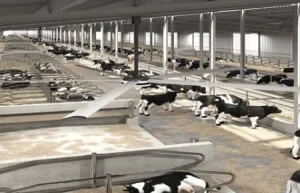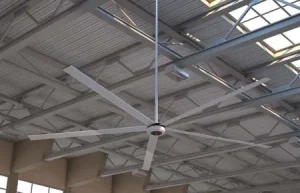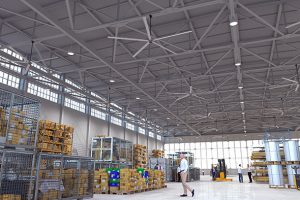Many large spaces struggle with stagnant air and temperature imbalances that lead to discomfort and higher energy costs. This situation gets worse with rising heat in industrial and commercial settings. By installing an HVLS fan, you can tackle these challenges, creating a comfortable environment while reducing expenses.
The benefits of HVLS fans include low speed yet high volume air circulation, reduced heating and cooling expenses, and enhanced indoor air quality. An HVLS fan works by efficiently moving large amounts of air throughout a space, creating balanced temperatures and alleviating humidity. This leads to lower energy consumption and better overall comfort.

HVLS fan in a warehouse
An HVLS fan (High-Volume, Low-Speed fan) is a large industrial and commercial solution that can move large volumes of air more effectively than a smaller, traditional ceiling fan. These fans are designed to operate at a low speed while still pushing a high volume of air throughout an area. Rather than spinning rapidly to create a sharp breeze, an HVLS fan uses massive fan blades to circulate the air at a comfortable pace.
Traditional ceiling fans typically move air over a smaller radius, and their fan speed is higher compared to an HVLS fan. In smaller rooms, a ceiling fan can bring relief from the heat. However, in spaces like a warehouse, distribution center, or gymnasium, a traditional fan may not circulate enough air from the ceiling to the floor area. That’s where an HVLS fan excels, thanks to its advanced design. By maintaining a low speed, HVLS fans produce minimal noise and use less energy, making them well-suited for large open facilities.
HVLS fans work by creating a continuous, gentle breeze that spreads across a large expanse. Since these fans are typically installed at high points (like ceilings in industrial spaces), they push air downward and then outward along the floor. This airflow pattern eliminates hot or cold pockets, effectively improving air circulation across every corner of the facility.
In a warehouse, especially a large industrial one, the strategic placement of an HVLS fan can significantly improve air quality. The fan’s massive blades draw warm air from the ceiling downward, which prevents heat from accumulating overhead—often referred to as destratification. This approach helps maintain a more even temperature at floor level, where workers and equipment are located.
The environmental benefits of HVLS fans are substantial, particularly in industrial spaces that require continuous temperature control. By running at a low speed, these fans reduce overall energy consumption, as they can take the place of multiple smaller fans or an overworked heating and cooling (HVAC) system. They also help to reduce energy costs by circulating conditioned air in a more balanced way.
Moreover, HVLS fans can contribute to better air quality in large industrial settings because they circulate stagnant pockets of warm air while pushing away moisture and contaminants. As a result, employees may experience fewer issues with stuffy conditions, and the overall environment remains more pleasant.
They’re labeled high volume low speed fans because they move a high volume of air at a relatively low speed. Traditional fans rely on speedy rotations to generate a noticeable breeze. However, HVLS fans harness their massive diameter to move large amounts of air with fewer rotations per minute.
• High Volume: The volume of air moved can reach tens of thousands of cubic feet per minute. These fans are capable of covering large areas—from a warehouse to open spaces like warehouses used for distribution—without creating disruptive gusts.
• Low Speed: The fan speed is intentionally kept low, thanks to the wide blades that advantage of hvls fans for gentle, uniform air movement. This helps mitigate noise levels while achieving robust airflow.
Because these fans are designed to efficiently handle large volumes of air, they are ideal for commercial and industrial spaces. The approach also leads to consistent air movement close to the ground.

Indeed, fans help improve productivity and working conditions by regulating temperature, dispersing fumes, and maintaining a more balanced environment. Excessive heat or poor ventilation in a warehouse or other industrial and commercial spaces directly impacts employee comfort and morale. When temperatures become too high, workers can feel sluggish, leading to reduced throughput.
By installing HVLS fans, you circulate the air throughout the facility, which helps keep the area cool in warmer months and pushes warm air down in colder periods. This consistent flow reduces temperature fluctuations that might otherwise cause employees to move more slowly, repeatedly stop for water breaks, or suffer from fatigue.
Furthermore, hvls fans help manage humidity. In certain climates, high humidity can cause sweat, discomfort, or even corrosion on sensitive equipment. HVLS fans, therefore, provide more comfortable working conditions and help lower the risk of equipment malfunctions due to moisture buildup.
Yes, employing an HVLS fan offers energy savings by lowering the need for extensive heating in colder seasons and assisting with cooling in warmer months. The fans can reduce heating costs by moving warm air from the ceiling level down to occupant level. This prevents heat loss through the roof, especially in large industrial buildings.
Meanwhile, in the summer, HVLS fans may work in tandem with your existing hvac system to create a cooler, more comfortable environment without cranking up the air conditioning. In both scenarios, you save on operational expenses. This benefit is part of the reason fans can reduce your monthly power bills. They move large volumes of air gently, enabling your facility to maintain ideal temperatures while consuming less energy overall.
Fans can also help to reduce the frequency of maintenance or high-capacity AC usage. By balancing out indoor temperatures, an HVLS fan eases the burden on climate control systems. Building managers and owners find themselves spending less on utilities and replacements.
HVLS fans create a uniform temperature distribution across large industrial spaces by pulling warm air from the ceiling and redistributing it at ground level. This technique ensures there are fewer temperature differences between ceiling and floor, so employees do not experience hot or cold spots. When workers know they can rely on stable climate control, it often boosts morale and performance.
Additionally, the fan performance is such that it promotes consistent airflow. The gentle nature of these fans means that employees feel a cooling sensation without getting hit by a harsh blast of air. This stable environment fosters longer work sessions with fewer breaks due to discomfort. For business owners, that translates to improved operational efficiency.
From my experience in industrial settings, the addition of HVLS fans not only influences employee well-being but can also help maintain machinery at optimal temperatures. Cooling air movement protects electronics from overheating, extending their lifespan and reducing downtime.
When it comes to industrial use, HVLS fans outperform a standard industrial ceiling fan due to size, power, and coverage. HVLS fans are industrial by design, typically featuring large fan blades and a specialized motor that deliver impressive yet smooth air movement.
HVLS fans better handle substantial areas because an industrial ceiling fan cannot easily move large volumes of air across bigger floor footprints. Additionally, a typical industrial ceiling fan often has fewer features for adjusting speeds or controlling directional airflow. HVLS fans on the market provide advanced control systems, customization options, and sensors designed to adapt to varied conditions.
Whether you run a large industrial workshop, a sports center, or an extensive manufacturing facility, one of the many advantages of these fans is their provide more comfortable working environment. They can handle everything from moderate heating and cooling needs to controlling humidity and improving indoor air quality.
The top benefits of HVLS fans in open spaces like warehouses revolve around temperature regulation, energy efficiency, and consistent air distribution. HVLS fans also reduce potential condensation on floors and product surfaces by encouraging evaporative cooling. This helps maintain product integrity and prevents water puddles that can lead to slip-and-fall issues.
In a warehouse fans setting, these fans compress mild temperatures downward. They push heated air toward worker level in winter and foster a gentle breeze to combat heat in warmer periods. Take advantage of HVLS fans to improve working conditions for personnel, keep stored goods at stable temperatures, and operate with better energy savings.
HVLS fans can also contribute to a quieter environment, which not only keeps employees happier but also aligns with compliance regulations that govern noise levels in industrial or commercial sites.
When you’re comparing hvls fan benefits to other ventilation solutions, certain factors stand out to improve air quality and overall comfort:
Fan Blades & Fan Speed
Commercial Fan and Commercial HVLS Fan
Large Industrial Fans
Effective Distribution
Less Heat Loss and More Comfort
Indoor air quality improves with a steady exchange of fresh air, and employees benefit from reduced heat stress. Over the long run, installing HVLS fans can transform large open or partially enclosed areas into a comfortable environment for all.

Large Industrial Fans
How important is destratification for large spaces?
Destratification ensures that warm air doesn’t stay near the ceiling, especially in tall buildings. By mixing the air effectively, large HVLS fans can reduce heating and cooling costs.
Do HVLS fans replace a heating or cooling system entirely?
They don’t replace central systems; rather, they complement them. These fans help regulate temperature distribution, reducing strain on HVAC systems and leading to fewer energy expenses overall.
Do HVLS fans work in smaller areas too?
They can, yet HVLS stands for “High Volume, Low Speed.” So, while they excel in large industrial spaces, smaller rooms might not need that level of air movement. However, mid-size commercial hvls fan models exist for moderate-sized facilities.
How does using HVLS fans in a warehouse enhance safety?
HVLS fans help keep floors dry by boosting evaporative cooling and air circulation. Reduced humidity lowers slip risks, and employees remain more alert in comfortable temperatures, contributing to fewer accidents.
Could HVLS fans increase noise levels?
In most cases, no. HVLS fans operate at a low speed with advanced motor technology, so they run quietly compared to multiple smaller fans or heavy-duty blowers. This helps maintain a calm work environment.
How do HVLS fans handle open spaces like warehouses with multiple floors?
If your facility has mezzanines or partial floors, multiple HVLS fans can be strategically placed to direct airflow across all levels. They help maintain even temperatures throughout all sections.
From firsthand experiences in constructing and servicing giant HVLS fans in manufacturing and distribution centers, I can confirm the significant impact on energy costs and occupant comfort. For further information, consider:
Contact us today to learn more about how our HVLS fans can transform your facility and deliver significant advantages for your bottom line!

Hi, I’m Michael Danielsson, CEO of Vindus Fans, with over 15 years of experience in the engineering and design industry. I’m here to share what I’ve learned. If you have any questions, feel free to contact me at any time. Let’s grow together!